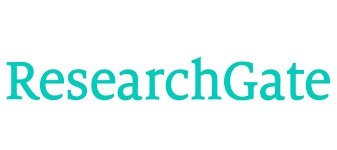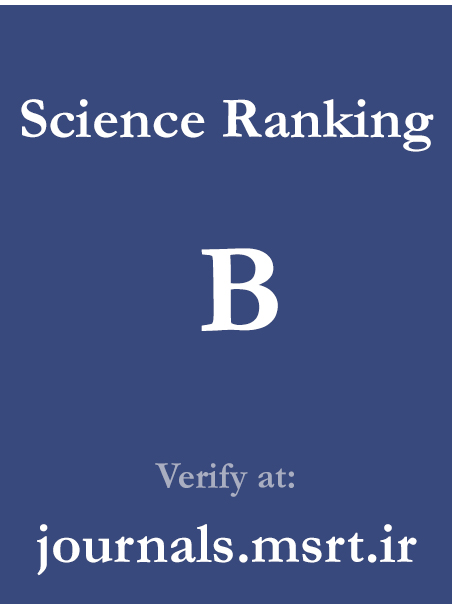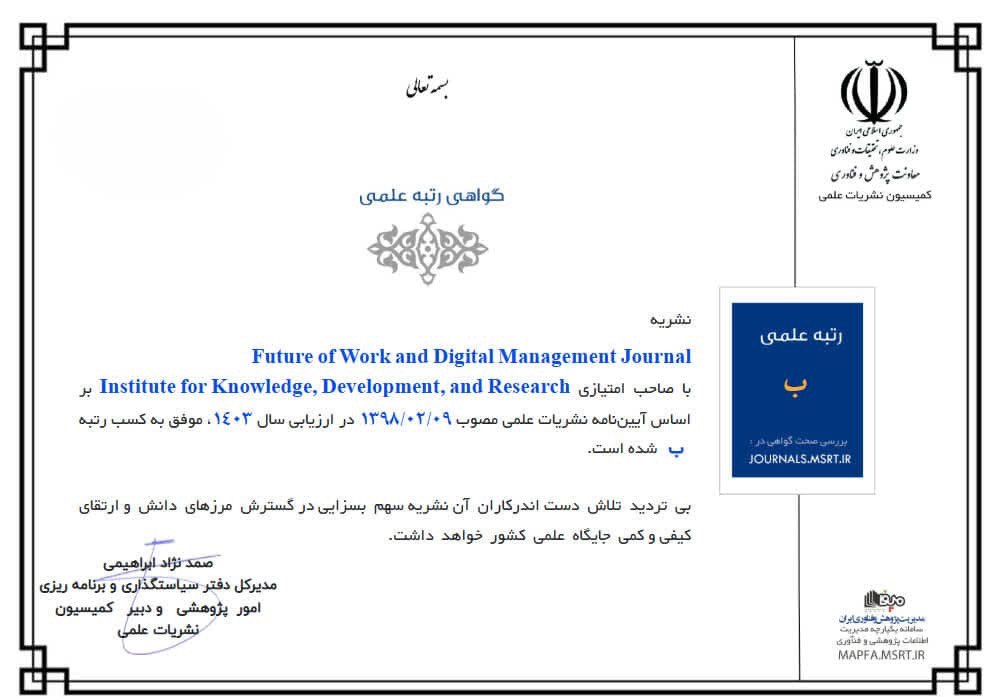Hybrid k-means and SVM machine learning for B2B customer segmentation:A case study banking for sustianable sales
Keywords:
B2B customer analysis, clustering, machine learning , sustainable sales, resource allocation, sales strategies, machine learning algorithms, customer loyalty, resource optimization, customer groupsAbstract
The effectiveness of segmenting Business-to-Business (B2B) customers is necessary to sales strategies and optimize resources. Several clustering methods have been documented in the literature, although limited research has studied the application of machine learning methods for sustainable sales optimization. This study addresses this gap by applying K-means and X-means clustering and Support Vector Machine (SVM) classification, to analyze and segment Bank Mellat B2B customers. Two data analysis methods were used as measures of the customers' transactional and behavioral activities, which included purchase history, frequency of interactions, and service usage. The analysis resulted in two segments of customer identified in the dataset: Cluster 0 consists of customers characterized by low engagement who are younger, and customers with less financial activity; Cluster 1 consists of customers characterized by high levels of engagement and are older while having high account balance and loyalty. The clustering method had an 89% degree of accuracy and SVM had 90% degree of accuracy based the final clustering and was validated with sensitivity analysis. These measures provide improved analytics and enable targeted engagement for further sustainability engagement, such as customer digital engagement for Cluster 0, Cluster 1 with loyalty programs are two targeted engagement methods enhancing resource optimization and further engagement by reducing physically-based interactions. This hybrid approach ultimately provided better engagement analytics measuring both unsupervised and supervised learning analyzed within the static and dynamic outcomes of the bank's data while offering a better scalable solution for profitability after customer engagement and retention. Future research imports an additional measure of sustainability inquiry examining tonsuring sustainability metrics and impacts through machine learning (ML) modeling.
Downloads
References
[1] M. Wu, P. Andreev, M. Benyoucef, and D. Hood, "Unlocking B2B buyer intentions to purchase: Conceptualizing and validating inside sales purchases," Decision Support Systems, 2024, doi: 10.1016/j.dss.2023.114165.
[2] M. Vieth, "Customer segmentation in B2B markets: the relationship between customer segmentation and market orientation," 2018.
[3] J. Elkington, Cannibals With Forks: The Triple Bottom Line of 21st Century Business. Oxford: Capstone, 1997.
[4] S. Flambard-Ruaud, "Relationship Marketing: An Innovation in Marketing Theory and Practice," 2015, doi: 10.1007/978-3-319-11845-1_70.
[5] M. Hitka et al., "Sustainability in Marketing through Customer Relationship Management in a Telecommunication Company," Molecular Microbiology, 2019, doi: 10.21272/MMI.2019.4-16.
[6] A. Miklosik, M. Kuchta, N. Evans, and S. Zak, "Towards the Adoption of Machine Learning-Based Analytical Tools in Digital Marketing," IEEE Access, 2019, doi: 10.1109/ACCESS.2019.2924425.
[7] B. H. Chen et al., "Uncloaking hidden repeating fast radio bursts with unsupervised machine learning," Monthly Notices of the Royal Astronomical Society, vol. 509, no. 1, pp. 1227-1236, 2022, doi: 10.1093/mnras/stab2994.
[8] S. N. Lathifah and Z. F. Azzahra, "AI-Driven Customers Segmentation Using K-Means Clustering," G-Tech: Jurnal Teknologi Terapan, vol. 9, no. 1, pp. 320-329, 2025, doi: 10.70609/gtech.v9i1.6202.
[9] A. Z. P. Aufa Zahrani Putri, "Penerapan Algoritma Fuzzy C-Means Pada Segmentasi Pelanggan B2B dengan Model LRFM," Jurnal Media Informatika Budidarma, vol. 7, no. 3, 2023, doi: 10.30865/mib.v7i3.6150.
[10] S. Mishra, P. Nayak, R. K. Mallick, D. A. Gadanayak, and G. Panda, "PQ event identification in PV-wind based distribution network with variational mode decomposition and novel feature enabled random forest classifier," International Journal of Emerging Electric Power Systems, vol. 25, no. 3, pp. 393-404, 2024, doi: 10.1515/ijeeps-2023-0123.
[11] M. Chattopadhyay and S. K. Mitra, "Elucidating strategic patterns from target customers using multi-stage RFM analysis," Journal of Global Scholars, 2023, doi: 10.1080/21639159.2022.2080094.
[12] A. B. Hadid, S. Bouguelia, and H. Kheddouci, "A New Method of B2B Customer Segmentation Based on Firmographic Data, and RFM and Graph Models," in 2024 IEEE International Conference on e-Business Engineering, 2024, pp. 81-86, doi: 10.1109/ICEBE62490.2024.00021.
[13] P. Li, C. Wang, J. Wu, and R. Madleňák, "An E-commerce customer segmentation method based on RFM weighted K-means," in 2022 International Conference on Management Engineering, Software Engineering and Service Sciences, 2022, pp. 61-68, doi: 10.1109/ICMSS55574.2022.00017.
[14] A. S. A. Alwabel and X. J. Zeng, "Data-driven modeling of technology acceptance: A machine learning perspective," Expert Systems With Applications, 2021, doi: 10.1016/j.eswa.2021.115584.
[15] T. Dahlberg and T. Nokkala, "A framework for the corporate governance of data - theoretical background and empirical evidence," 2015, doi: 10.3846/bme.2015.254.
[16] J. B. Barney, "Firm resources and sustained competitive advantage," Journal of Management, vol. 17, no. 1, pp. 99-120, 1991, doi: 10.1177/014920639101700108.
[17] O. Wisesa, A. Andriansyah, and O. I. Khalaf, "Prediction Analysis for Business To Business (B2B) Sales of Telecommunication Services using Machine Learning Techniques," Majlesi Journal of Electrical Engineering, 2020, doi: 10.29252/MJEE.14.4.145.
[18] M. R. A. Purnomo, A. Azzam, and A. U. Khasanah, "Effective Marketing Strategy Determination Based on Customers Clustering Using Machine Learning Technique," 2020, doi: 10.1088/1742-6596/1471/1/012023.
[19] L. Abidar, D. Zaidouni, and A. En-Nouaary, "Customer Segmentation With Machine Learning: New Strategy For Targeted Actions," in International Conference on Intelligent Systems: Theories and Applications, 2020, doi: 10.1145/3419604.3419794.
[20] N. Sakina, A. P. Arun, and P. K. Gupta, "Optimizing Customer Segmentation: A Comparative Analysis of Clustering Algorithms Using Evaluation Metrics," in 2024 8th International Conference on Computational System and Information Technology for Sustainable Solutions, 2024, pp. 1-6, doi: 10.1109/CSITSS64042.2024.10816952.
[21] K. K. Agrawal and G. Agarwal, "A Comparative Study of Deep Learning vs. Machine Learning Algorithms for Brain Tumor Detection," in 2024 1st International Conference on Advances in Computing, Communication and Networking, 2024, pp. 1001-1005, doi: 10.1109/ICAC2N63387.2024.10894885.
[22] A. Manzoor, M. A. Qureshi, E. Kidney, and L. Longo, "A Review on Machine Learning Methods for Customer Churn Prediction and Recommendations for Business Practitioners," IEEE Access, 2024, doi: 10.1109/ACCESS.2024.3402092.
[23] L. Han, J. Fang, Q. Zheng, B. T. George, and M. Liao, "Unveiling the effects of livestream studio environment design on sales performance: A machine learning exploration," Industrial Marketing, 2024, doi: 10.1016/j.indmarman.2023.12.021.
[24] S. Horng and P. Yenradee, "Delivery Service Management System Using Google Maps for SMEs in Emerging Countries," Computers, Materials & Continue, 2023, doi: 10.32604/cmc.2023.038764.
[25] M. O'Brien, Y. Liu, H. Chen, and R. F. Lusch, "Gaining insight to B2B relationships through new segmentation approaches: Not all relationships are equal," Expert Systems With Applications, 2020, doi: 10.1016/j.eswa.2020.113767.
[26] A. Sheikh, T. Ghanbarpour, and D. Gholamiangonabadi, "A preliminary study of fintech industry: a two-stage clustering analysis for customer segmentation in the B2B setting," 2019, vol. 26, 2 ed., pp. 197-207, doi: 10.1080/1051712X.2019.1603420.
[27] S. GhGolamveisy et al., "Application of data mining technique for customer purchase behavior via Extended RFM model with focus on BCG matrix from a data set of online retailing," Journal of Infrastructure, Policy and Development, vol. 8, no. 7, p. 4426, 2024, doi: 10.24294/jipd.v8i7.4426.
[28] S. Sancar and M. Uzun-Per, "Feature Selection in Customer Churn Analysis: Case Study in B2B Business," in IEEE International Conference on E-Business Engineering, 2022, doi: 10.1109/ICEBE55470.2022.00053.
[29] A. B. Madeira, J. A. G. d. Silveira, and L. A. Toledo, "Marketing Segmentation: Your Role For Diversity in Dynamical Systems," GESTÃO.Org: Revista Eletrônica de Gestão Organizacional, 2015.
[30] S. Ozan, "A Case Study on Customer Segmentation by using Machine Learning Methods," in International Conference on Artificial Intelligence, 2018, doi: 10.1109/IDAP.2018.8620892.
[31] I. Fuentes, I. Fuentes, G. Nápoles, L. Arco, L. Arco, and K. Vanhoof, Customer Segmentation Using Multiple Instance Clustering and Purchasing Behaviors. 2018.
[32] D. A. Kandeil, A. A. Saad, and S. M. Youssef, "A two-phase clustering analysis for B2B customer segmentation," in 2014 International Conference on Intelligent Networking and Collaborative Systems, 2014, pp. 221-228, doi: 10.1109/INCoS.2014.49.
[33] W. Zhu, N. Zeng, and N. Wang, "Sensitivity, specificity, accuracy, associated confidence interval and ROC analysis with practical SAS implementations," NESUG Proceedings: Health Care and Life Sciences, p. 67, 2010.
[34] N. R. Maulina, I. Surjandari, and A. M. M. Rus, "Data Mining Approach for Customer Segmentation in B2B Settings using Centroid-Based Clustering," in International Conference on Service Systems and Service Management, 2019, doi: 10.1109/ICSSSM.2019.8887739.
Downloads
Published
Submitted
Revised
Accepted
Issue
Section
License
Copyright (c) 2025 Seyyed Amir Masoud Homayooni (Author); Mahdi Mohamadi (Translator)

This work is licensed under a Creative Commons Attribution-NonCommercial 4.0 International License.







